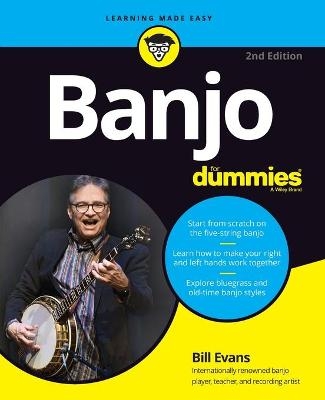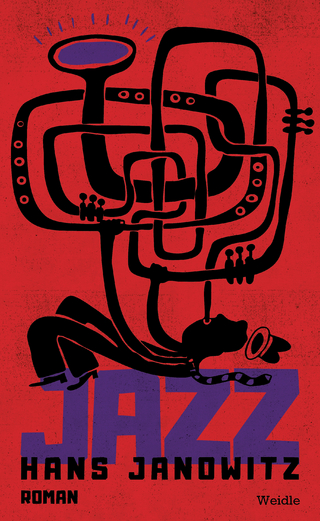
Banjo For Dummies
For Dummies (Verlag)
978-1-119-73138-2 (ISBN)
The banjo is both a staple of old-time music and an instrument that makes frequent cameos in today’s chart toppers. Whatever your musical leanings, Banjo For Dummies will show you how to pick your way around your instrument, even if you have zero musical background! With a little practice—and the easy-to-follow instructions in this book—you can learn your way around the banjo, try out various musical styles, and discover what banjo culture is all about.
Think of this For Dummies guide as your personal banjo tutor, as you learn how to buy, tune, hold, play, and have fun with your five-string. You can also go beyond the book with online video lessons and audio files that will get you picking even faster. Follow the guidance of respected banjo performer Bill Evans and soon you may find yourself jamming with a band or rubbing elbows with the pros at your local bluegrass festival.
Learn the basics of banjo: how to strum chords, pick notes, and read tablature
Add new styles to your repertoire, including clawhammer, three-finger styles, vamping, and classic banjo
Play bluegrass music and learn how to network at festivals
Choose the banjo and accessories that work for you, and discover how to keep them in good shape
Banjo For Dummies is for anyone who want to learn to play the five-string banjo or brush up on banjo-playing skills. No experience required!
Bill Evans is an internationally celebrated five-string banjo player, teacher, historian, and recording artist, who has helped thousands of banjo players globally get the most out of their instruments. He's also performed throughout the world and his CDs have topped both folk and bluegrass charts.
Introduction 1
About This Book 1
Foolish Assumptions 2
Icons Used in This Book 3
Beyond the Book 3
Where to Go from Here 4
Part 1: The Amazing Five-String Banjo 5
Chapter 1: You Want to Play What?: Banjo Basics 7
Getting into Banjo 7
Loving that amazing sound 8
Becoming a true believer 8
Identifying Different Kinds of Banjos 9
Five-string banjo: The subject of this book 9
Tenor and plectrum banjos: Look for another book 10
Knowing the Parts of a Banjo 12
Looking at the neck 15
Checking out the pot 16
Picking up string vibrations 17
Becoming a Banjo Player 18
Making wise purchase choices 19
Tuning and holding your banjo 19
Fretting chords with the left hand 19
Playing authentic right- and left-hand patterns 20
Practicing some real tunes 20
Jamming in good company 20
Meeting other banjo lovers 21
Keeping your banjo sounding great 21
Chapter 2: Tuning Your Banjo 23
G Tuning: Getting Your Strings in Order 24
Relative Tuning: Tuning the Banjo to Itself 25
Reference Tuning: Getting a Little Outside Help 27
Using an electronic tuner 27
Tuning with an electronic tuner at a jam session 30
Using another instrument as a reference 30
Chapter 3: Starting to Play: Fretting and Strumming 35
Talking Banjo Talk 36
Positioning Body and Banjo 37
Strapping on your banjo 38
Sitting down to play 41
Standing with your banjo 42
Fretting with the Left Hand 44
Fingering G, D7, and C Chords 46
The G chord: Real easy 47
The D7 chord: A little harder 47
The C chord: More challenging still 47
Checking Out Chord Diagrams 48
Reading a chord diagram 48
Interpreting up-the-neck chord diagrams 50
Chord Progressions: Playing Your First Song 51
Chapter 4: Playing by the Rules: Songs and Tablature 53
Breaking Down the Parts of a Song 54
Feeling the rhythm 54
Finding the melody 59
Reading Tablature 65
Finding notes 65
Tracking down the rhythm 66
Playing Pinch Patterns 68
Being a Great Team Player 71
Lead playing: Shining the spotlight on yourself 71
Backup playing: Allowing others to stand out 72
Part 2: Let’s Pick! Basic Banjo Techniques 75
Chapter 5: Getting Right with the Right Hand 77
Clawhammer and Bluegrass: Down-Picking and Up-Picking 78
Clawhammer Right-Hand Basics 79
Finding a good right-hand position 80
Playing your first clawhammer notes 81
Using clawhammer banjo as accompaniment 85
Bluegrass Right-Hand Basics 87
Choosing and fitting thumbpicks and fingerpicks 87
Acquiring a good right-hand position 92
Playing roll patterns 97
Using bluegrass rolls as accompaniment 100
Chapter 6: Sliding, Hammering, and Pulling: Adding the Left Hand 103
Slipping into the Slide 104
Getting down the slide: The basics 105
Trying 3rd-string slides 106
Undertaking 4th-string slides 106
Focusing on 1st-string slides 107
Nailing the Hammer-On 108
Playing open-string hammer-ons 108
Giving fretted hammer-ons a chance 110
Pulling Off the Pull-Off 111
Digging into open-string pull-offs 112
Mastering fretted pull-offs 112
Sizing up special clawhammer pull-offs 114
Bending the Chokes 114
Playing the Foggy Mountain choke 114
Experimenting with choke variations 116
Putting Your Hands Together 116
Making sure your clawhammer right hand is ready 117
Double-checking your bluegrass right-hand skills 118
Joining forces: Using both hands in clawhammer banjo 118
Keeping both hands busy in bluegrass banjo 123
Chapter 7: Working Up Your First Tunes: Clawhammer and Bluegrass 129
Stylin’ It: Playing Real Banjo Music 130
Starting with the right hand 131
Adding the left hand 133
Tackling a Few More Tunes 136
Part 3: Playing Styles Past, Present, And Future 141
Chapter 8: Playing the Old-Time Way: Clawhammer and Traditional Styles 143
Digging Deeper into Clawhammer Banjo 144
Fretting 1st-string clawhammer pull-offs 144
Stretching out with double thumbing 145
Discovering Four Clawhammer Classics 146
Playing “Old Joe Clark” 147
Turning on to double C tuning 148
Playing “Soldier’s Joy” 149
Moving into modal tuning 150
Playing “Cluck Old Hen” 151
Discovering Pete Seeger–Style Banjo 153
Syncing with the Seeger stroke 154
Playing “Swing Low” and “Little Birdie” with the Seeger stroke .155
Fingerpicking the Old-Time Way 156
Exploring Dock Boggs’s style with “Pretty Polly” 156
Picking “Coal Creek March” 158
Chapter 9: Playing Three-Finger Styles: Scruggs, Melodic, and Single String 161
Playing Scruggs-Style Banjo 162
Flowing with the rolls 162
Making your music hot with some licks 165
Progressing to Scruggs-style songs 170
Making Music with Melodic Banjo 172
Discovering how to play melodic scales 172
Getting a feel for melodic banjo songs 175
Playing Single-String Banjo 179
Using the right hand 180
Taking a crack at single-string scales 182
Exercising single-string techniques in songs 186
Combining Three-Finger Techniques 190
Chapter 10: Playing Up-the-Neck Backup: Chords and Vamping 195
Playing Movable Major Chords 196
The barre shape 196
The F shape 198
The D shape 199
Moving from the F shape to the D shape 200
Playing Movable Minor Chords 200
Converting F-shape major chords 201
Converting D-shape major chords 202
Converting barre-shape major chords 203
Using Vamping in Backup Playing 205
Working out the mechanics of vamping 205
Using F and D shapes with vamping 206
Knowing When to Use Vamping 207
Chapter 11: Playing Historical Styles: African, Minstrel, and Classic Banjo 209
Exploring African-American Banjo Roots 210
Converging Cultures: The World of Minstrel Banjo 211
Uncovering the historical background 211
Getting into minstrel banjo 212
Discovering drop-C tuning 212
Mastering minstrel technique 213
Trying some minstrel tunes 214
Branching Out with Classic Banjo 215
Understanding classic banjo technique 216
Introducing yourself to the classics 216
Chapter 12: Networking into Banjo Culture 221
Taking Private Lessons 222
Overcoming lesson anxiety 222
Finding the right teacher 223
Playing Music with Others 226
Finding a good jam 226
Getting ready for a jam session 227
Joining in a jam 228
Observing good jamming etiquette 230
Attending Workshops and Camps 231
Workshops: Fine-tuning your techniques 231
Banjo, bluegrass, and old-time camps: Rubbing elbows with the pros 232
Heading to a Bluegrass Festival 235
Discovering what festivals are all about 235
Finding a festival that’s right for you 237
Part 4: Buying A Banjo and Keeping It In Good Shape 239
Chapter 13: Finding Your Banjo Bliss: A Buyer’s Guide 241
Establishing Your Banjo Boundaries 242
Making the Leap: Resonator or Open-Back? 243
Pumping up the volume: Resonator banjos 243
Going the old-time way: Open-back banjos 245
Finding a Great Beginner’s Banjo 246
Knowing what’s in the pot 246
Getting good string action 246
Finding bridge height 247
Measuring string spacing 249
Checking the tuners 249
Taking the plunge 252
Stepping Up to a Better Banjo 253
Budgeting for a quality banjo 254
Knowing a quality banjo when you see it 255
Plugging in: Electric banjos 259
Going vintage 261
Finding the Right Music Store 263
Buying from an acoustic specialty store 263
Buying online 264
Getting you started: A banjo store directory 265
Chapter 14: Getting the Right Stuff: Banjo Gear 267
Picking Up the Stuff You Really Need 267
Cases: Becoming King of the Road 268
Strings: You can’t pick without ’em 273
Picks: Giving your fingers playing power 277
Straps: Take a load off! 278
Capos: Playing easily in different keys 278
The 5th-string capo and spikes: Going along for the ride 281
Electronic tuners: Getting by with a little help 283
Collecting More Cool Tools to Help Your Playing 285
Metronomes and drum machines 285
Your computer and the banjo 288
Chapter 15: Taking Care of Your Baby: String Changing and Basic Maintenance 291
Replacing Banjo Strings 292
Deciding when your strings need a changin’ 292
Changing strings 1 through 4: A step-by-step guide 293
Replacing the 5th string 299
Setting the Bridge 300
Discovering harmonics 301
Using harmonics to set the bridge 301
Adjusting Head Tension 303
Relating head tension to banjo tone 303
Tightening the head 304
Keeping Your Banjo Looking Its Best 307
Knowing When to Consult a Professional 309
Part 5: The Part of Tens 311
Chapter 16: Ten Tips to Make Practicing More Fun 313
Practice Regularly 313
Set Goals 314
Warm Up 315
Use Tablature Sparingly 315
Get the Right Hand First 316
Gradually Increase Your Speed 316
Take Songs One Measure at a Time 317
Play the Right Repertoire 318
Listen Actively 318
Keep Track of Your Progress 319
Chapter 17: Ten Great Banjo Players You Need to Hear 321
Earl Scruggs (1924–2012) 321
Pete Seeger (b 1919) 322
Béla Fleck (b 1958) 322
Bill Keith (b 1939) 323
Mike Seeger (1933–2009) 323
Don Reno (1927–1984) 323
J D Crowe (b 1937) 324
Tony Trischka (b 1949) 324
Alison Brown (b 1962) 325
Jens Kruger (b 1962) 325
Part 6: Appendixes 327
Appendix A: Banjo Chords and Notes 329
Chords 329
Notes on the Banjo in G Tuning 332
Appendix B: Audio Tracks and Video Clips 335
Discovering What’s on the Audio Tracks 335
Looking at What’s in the Video Clips 340
Customer Care 342
Index 343
| Erscheinungsdatum | 15.01.2021 |
|---|---|
| Sprache | englisch |
| Maße | 183 x 231 mm |
| Gewicht | 522 g |
| Themenwelt | Kunst / Musik / Theater ► Musik ► Instrumentenkunde |
| ISBN-10 | 1-119-73138-0 / 1119731380 |
| ISBN-13 | 978-1-119-73138-2 / 9781119731382 |
| Zustand | Neuware |
| Haben Sie eine Frage zum Produkt? |
aus dem Bereich


